Getting Away with Murders at Karlov Manor, Part 1
Welcome to the first week of Murders at Karlov Manor previews. There are many mysteries afoot, some of which I'll tackle today. Why did we decide to do a mystery-themed set? How exactly was Murders at Karlov Manor designed? Who were the culprits that designed it? What mechanics did they use to commit such a crime? I'll investigate today and next week and provide some answers. I might even uncover some preview cards along the way.
Accessories to Murders
Before I can get to the why and how of the crime, let's start with the who. Many people worked to design Murders at Karlov Manor. Let's meet them. As always, I'm having the lead of the sets do the introductions. For Murders at Karlov Manor, Mark Gottlieb was the co-lead for both vision design (with me) and set design (with Andrew Brown), so I'm having him introduce everyone.
Note: The bios talk a bit about the larger puzzle embedded in Murders at Karlov Manor and even have a bonus puzzle for you to solve, so if you don't normally read the bios, you might want to check these ones out.
-
Click here to meet the Exploratory, Vision, and Set Design teams
-
Hello! Mark Rosewater asked me to step in and write up the bios for the nineteen(!) members of the Murders at Karlov Manor Exploratory Design, Vision Design, and Set Design teams. I then went ahead and generally asked them to write their own bios, but I added a bit of personal detail to each one. I think you'll learn some interesting new tidbits as you read.
Mark Gottlieb, Principal Game Designer (Co-lead, Vision and Set Design)
I love mysteries and puzzles, so I was thrilled to have the chance to lead Murders at Karlov Manor design. But I wasn't just the lead designer for the card set, I was also the lead designer of the puzzle experience that's embedded within Murders at Karlov Manor. Starting with Prerelease, one new puzzle will unlock each day on RavnicaDetectiveAgency.com. Look for clues in Murders at Karlov Manor cards and products to solve all thirteen of them!
Fun fact: Ironically, shortly after this set wrapped up, I was murdered by one of the other Murders at Karlov Manor designers. (Oh, right. I'm a ghost now. Boo.) We had all gathered to celebrate. We arrived at a place that contained ten different rooms, numbered in order from 1–10. Each designer entered one room. Four of the rooms had three people in them, five had just one person in them, and exactly one room had two people in it. I was one of the two people in that room. My killer was the other. (Can't have any witnesses.) Who killed me?
- Solving this mystery is not one of the thirteen puzzles that's part of the RavnicaDetectiveAgency.com hunt. It's just to get you in the mood.
- In fact, I'd say that this puzzle is more difficult than any of those puzzles.
- You'll need all the bios to solve the mystery.
Mark Rosewater, Magic Head Designer (Lead, Exploratory Design; Co-lead, Vision Design)
Mark is the author the article you're reading right now (except for this bit)! He also dabbles in game design from time to time.
Fun fact: Mark Rosewater was in room #1.
Annie Sardelis, Senior Game Designer (Exploratory and Vision Design)
Annie started her fifth year at Wizards doing a combination of vision design, Commander design, and Universes Beyond design (and still can't pick a favorite). She pitched the idea that became the "collect evidence" mechanic in Murders at Karlov Manor. When it comes to detective media, she's a big fan of Case Closed and Phoenix Wright!
Fun fact: There were exactly four people total in the two rooms adjacent to the room Annie Sardelis was in.
Ethan Fleischer, Senior Game Designer (Exploratory Design)
Ethan has led many Magic design teams, usually with the Vision Design team. He oversees the design philosophy of our Universes Beyond sets.
Fun fact: Add Doug Beyer's room number to Ethan Fleischer's room number, and the sum is Jeremy Geist's room number.
Erik Lauer, Game Design Architect (Vision and Set Design)
Erik recently retired after an astounding career in Magic game design. Also, he streamed every episode of How I Met Your Mother because Mark Rosewater said the ending was bad.
Fun fact: Erik Lauer's room had the second-lowest room number that contained exactly one person.
Doug Beyer, Creative Director (Vision Design)
Doug is the creative director for Magic worldbuilding. He loves it when we get to combine fun Magic mechanics with detective coats—er, that is, evocative flavor.
Fun fact: Doug Beyer's room had a lower room number than Erik Lauer's.
Dan Musser, Senior Game Designer (Vision Design)
Dan joined Wizards of the Coast during the development of Modern Horizons in 2017. Nowadays, he manages the Competitive Play Design team and works on a variety of Magic design projects. In his spare time, he enjoys watching basketball with his dogs Mochi and Soju.
Fun fact: No set of three consecutive rooms contained the same number of people. This isn't really a fun fact about Dan specifically, but he feels very strongly about it.
Chris Mooney, Senior Game Designer (Vision Design)
Chris was on the Murders at Karlov Manor team briefly but long enough to help design the "collect evidence" mechanic. They like their mysteries like they like their draft formats: unsolved.
Fun fact: Ethan Fleischer's room number was one more than Chris Mooney's room number.
Daniel Xu, Game Designer (Vision Design)
Daniel values novelty and elegance in Magic design. His favorite mystery story is "The Adventure of the Speckled Band."
Fun fact: Daniel Xu, Dan Musser, and Daniel Holt were all in the same room.
Michelle Roberson, Game Designer (Vision Design)
Michelle was on the events team before moving over to game design. She was one of the original members of the Casual Play Design team. She was also on my Streets of New Capenna and Jumpstart 2022 design teams.
Fun fact: Chris Mooney's room number was one more than Michelle Roberson's room number.
Andrew Brown, Principal Game Designer (Co-lead, Set Design)
Andrew enjoys long walks on the beach, gaining 1 life when he plays a land, and good (bad) puns. He has won more games of sanctioned Magic than anyone else in this article. Scoreboard!
Fun fact: The two rooms adjacent to the room Andrew Brown was in each contained exactly one person.
Yoni Skolnik, Principal Game Designer (Set Design)
In a former life as a college student, Yoni participated in eight comedic murder mystery plays as some combination of performer, director, and/or writer. Nowadays, Yoni leads sets like Strixhaven: School of Mages and The Brothers' War. His time on the Murders at Karlov Manor team was focused on deepening Limited color-pair themes.
Fun fact: Yoni Skolnik and Chris Kvartek were in different rooms, and each of their room numbers was a square number.
Jadine Klomparens, Senior Game Designer (Set Design)
Sets Jadine has worked on the most include Modern Horizons 2, Kamigawa: Neon Dynasty, and March of the Machine. These days, she spends a few months on each Standard-legal set at the end of set design to get it ready for the Play Design team to begin work on it in FFL (Future Future League).
Fun fact: Jadine Klomparens's room number was exactly half of Erik Lauer's room number.
Daniel Holt, Senior Game Designer (Set Design)
While Daniel is a renowned Kamigawa fan, he played a big role in shaping this Ravnica setting by being a game designer on both the main set and Commander deck design teams, as well as creating the set symbol, new counter icons, and the mechanical frame for Cases.
Fun fact: Add Daniel Holt's room number to Eric Engelhard's room number, and the sum is Aaron Sorrells's room number.
Eric Engelhard, Senior Game Designer (Set Design)
Eric came to us with more than a decade of experience as a lead game designer for collectible games. He brought some of his unique design experience and outside-the-box thinking to this, his first set team. As part of the Play Design team, he contributed to sets from The Brothers' War to Outlaws of Thunder Junction and is currently leading vision design and set design for an upcoming set.
Fun fact: Eric Engelhard's room number was one more than Cameron Williams's room number.
Chris Kvartek, Game Designer (Set Design)
Murders at Karlov Manor was the first set team that Chris was a part of. He's a Limited devotee and is especially excited to hear our player base's opinions of the draft environment!
Fun fact: The sum of the room numbers for rooms that Chris Kvartek, Andrew Brown, Annie Sardelis, and Michelle Roberson were in is the same as the sum of the room numbers for rooms that Dan Musser, Doug Beyer, Ethan Fleischer, and Eric Engelhard were in. (Any of them might have been in the same room.)
Jeremy Geist, Game Designer (Set Design)
Jeremy came to Wizards of the Coast via Great Designer Search 3. Murders at Karlov Manor is the first draftable set he worked on, in order of release.
Fun fact: If you take Jeremy Geist's room number and Annie Sardelis's room number and subtract the smaller one from the larger one, the result is 7.
Cameron Williams, Game Designer (Set Design)
Cameron's favorite mysteries are elaborate visual novels like Danganronpa and Zero Escape, so the Set Design team had to keep talking him down whenever he pitched cards based on time travel or virtual reality. (Ravnican murderers are philistines).
Fun fact: If Cameron Williams was in an odd-numbered room, only one person was in room #10. If Cameron was in an even-numbered room, more than one person was in room #10.
Aaron Sorrells, Summer Intern (Set Design)
Aaron joined us for a ten-week internship in the summer of 2022, when Murders at Karlov Manor was in the tail end of its set design phase. During that time, he served as a full member of the Murders at Karlov Manor Set Design team, where he helped design around problems we encountered, redesign cards to iterate and refine Limited, and design new cards to fill out and upgrade our rares.
Fun fact: Room #7 had three people in it (though Aaron may or may not have been one of them).
A Mystery Is Revealed
Let's begin with the first mystery, the theme of mystery itself. How did we end up with it? Well, the story goes all the way back to 1997. Michael Ryan and I felt that Magic should have an ongoing story, so we pitched what is now known as the Weatherlight Saga. As part of that pitch, we laid out plans for a three-year arc that would take place across three different blocks, each on its own plane. While the Weatherlight Saga happened, it deviated a bit from the three-year story we first pitched. Most of the first year remained, as did parts of the second year (although it was pushed back to year three). It's the second-year part that's relevant.
The first year was set on Rath and the second year on Mercadia (again, the second year was pushed back a year so that we could go into the past and tell the Urza's Saga portion of the story). Volrath had snuck aboard the Weatherlight and killed Starke while in Mercadia. Michael and I had the cool idea of turning Starke's murder into a murder mystery. The idea was to have Starke killed in the beginning of the story and the mystery of his murderer woven throughout the set.
We had this elaborate plan where the murder occurred in a castle and different pieces of art would help you figure out the layout of the castle, which would be key to solving the murder. The murderer of our story was Tahngarth, but not the actual Tahngarth, as he had been replaced by Volrath.
A little behind-the-scenes trivia: We made Volrath a shapeshifter to set up the murder mystery. The Weatherlight Saga changed much along the way, including Michael and I being far less involved in it, so the idea of the murder mystery set never happened, but it was always an idea near and dear to my heart.
Flash forward many years to the original Innistrad release. It had been a big success, and it made me realize the power of top-down design based on fictional genres. I ended up making a list of genres that blend well with fantasy. Fairy tales were at the top, which would lead to Throne of Eldraine, but murder mystery was also on my list. It had a lot of juicy tropes that would make good cards, and I still loved the idea of a Magic set with a puzzle built into it. (Next week, I will talk more about the puzzles that are embedded in Murders at Karlov Manor.)
From time to time, we do something we call arc planning. Now, it's a weekly meeting, but it wasn't always. In the past, we'd have an offsite for a few days to line up the next few years' worth of sets. I wrote a two-part article called "The Bolas Arc" (Part 1 and Part 2) a few years ago that gives a little peak into the process. (The article specifically talks about the sets from the Bolas Arc storyline.)
At these meetings, we often throw out set ideas that we have. Some stick, and some don't. Usually, if you have one you like, you keep bringing it up, trying to find the place where it'll make sense in the larger structure. A top-down murder mystery plane was an idea that had been tossed out a few times. I'm not quite sure why "Polo," the code name for Murders at Karlov Manor, became the home for it, but I, with the help of a few others, got everyone on board, and it was added to the schedule.
Note, I said murder mystery plane. The initial idea was for it was to be a brand-new plane optimized to play into all the tropes the genre wanted us to hit. Usually, when we did a top-down plane, we created something brand new so we could adapt it however we needed to optimize the set. But then we made Kamigawa: Neon Dynasty. That set started as a top-down Japanese pop culture-inspired set. Instead of making a new plane, we repurposed a plane we already had that seemed like a good fit. This would eventually lead us to change The Lost Caverns of Ixalan from a new underground plane to Ixalan.
In the middle of vision design, the Worldbuilding and Vision Design teams both realized that the plane we were building felt a lot like Ravnica. The trope space demanded a city complete with efficient law enforcement (New Capenna was a bit light on the latter), and we didn't feel a need to reinvent the wheel. If the plane felt like Ravnica, why not make it Ravnica? There was discussion about some players being upset that we returned to Ravnica and didn't have guild-themed play, but Ravnica Remastered was coming out a month before it, so we felt that would give access to players who wanted it.
The Plot Thickens
With that out of the way, our story goes back to the start of exploratory design when we were figuring out what a murder mystery set would need mechanically. Obviously, we would have a lot of flavorful top-down card designs hitting all the fun mystery tropes. But what should our mechanics accomplish such that the gameplay feels like it belongs in a murder mystery? I'm going to talk about two of them today and the rest next week.
First up, Magic already did a mystery set. It wasn't exactly a murder mystery, and it didn't play into the tropes quite as strongly as we wanted to with this set, but it forced us to ask ourselves the question of how to make mechanics that feel like a mystery. That set was Shadows over Innistrad. We were revisiting Innistrad for the first time, and we decided to shift the horror from gothic horror to cosmic horror. A big part of cosmic horror is an element of mystery, so we had Jace show up on Innistrad, put on a trench coat, and solve a mystery.
The main mechanic we came up with to capture the sense of investigating a mystery was the investigate mechanic, which created Clue tokens that allow you to pay mana to draw a card. This was the first time we played around with a noncreature token that was made in volume. Eldritch Moon, the next set, didn't use investigate because the story shifted away from the mystery part and more into horror. Players really liked investigate and let us know they wanted to see it again. We would bring it back on our next return to Innistrad, Innistrad: Midnight Hunt.
All of this is to say, when we asked ourselves what mechanics make sense in a murder mystery set, the very first thing we thought of was investigate. We put it in and never looked back. As a keyword action (i.e., a verb; something that happens), there's a lot of flexibility in how we can use it. In fact, all three of today's preview cards make use of it in different ways. So, before we continue on, I thought I would show them off.
First up is Homicide Investigator. If you were a citizen of Ravnica, this isn't someone you'd want to meet. When she shows up, someone's dead. Hopefully, not you.
-
Click here to reveal Homicide Investigator
-
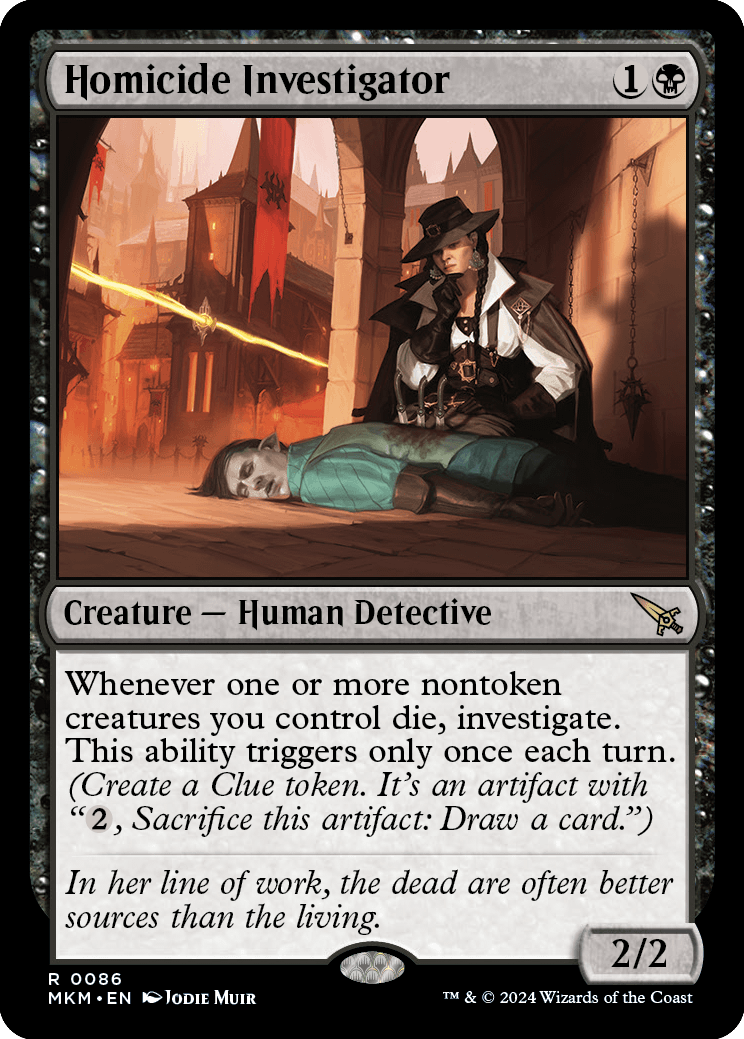
Homicide Investigator 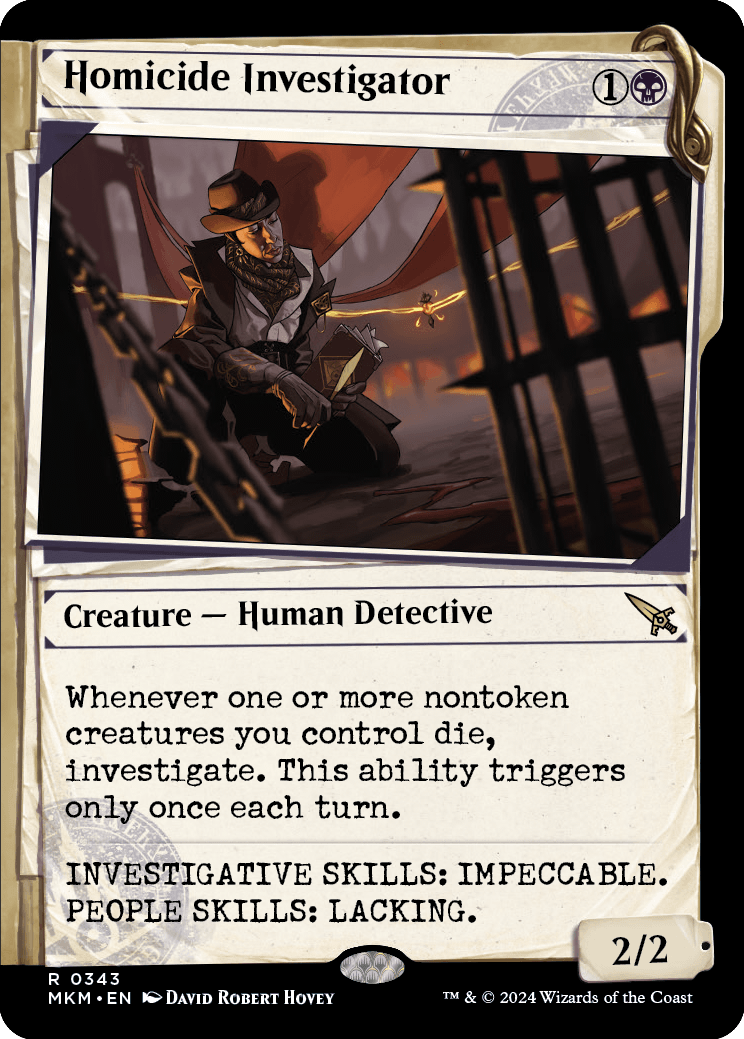
Homicide Investigator (Showcase Dossier) As you can see, she makes use of investigate as an effect of a trigger. This allows you, with the right deck, to make use of her ability turn after turn.
Second is Sharp-Eyed Rookie. Sharp-Eyed Rookie is another Detective intent on solving murders.
-
Click here to reveal Sharp-Eyed Rookie
-
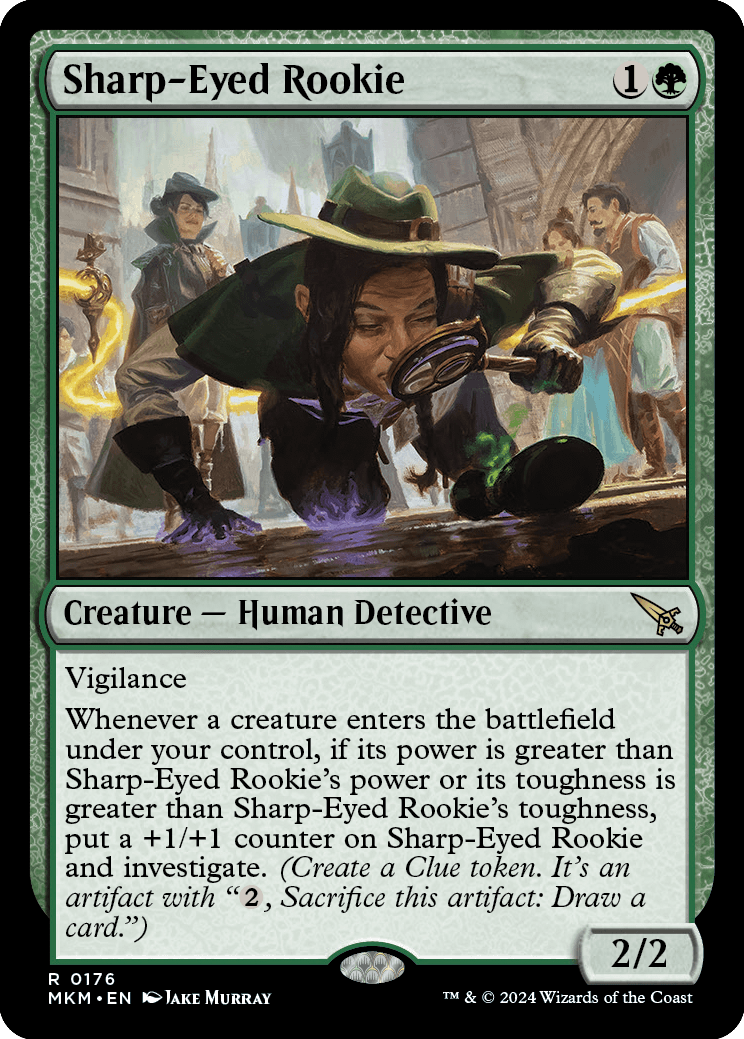
Sharp-Eyed Rookie 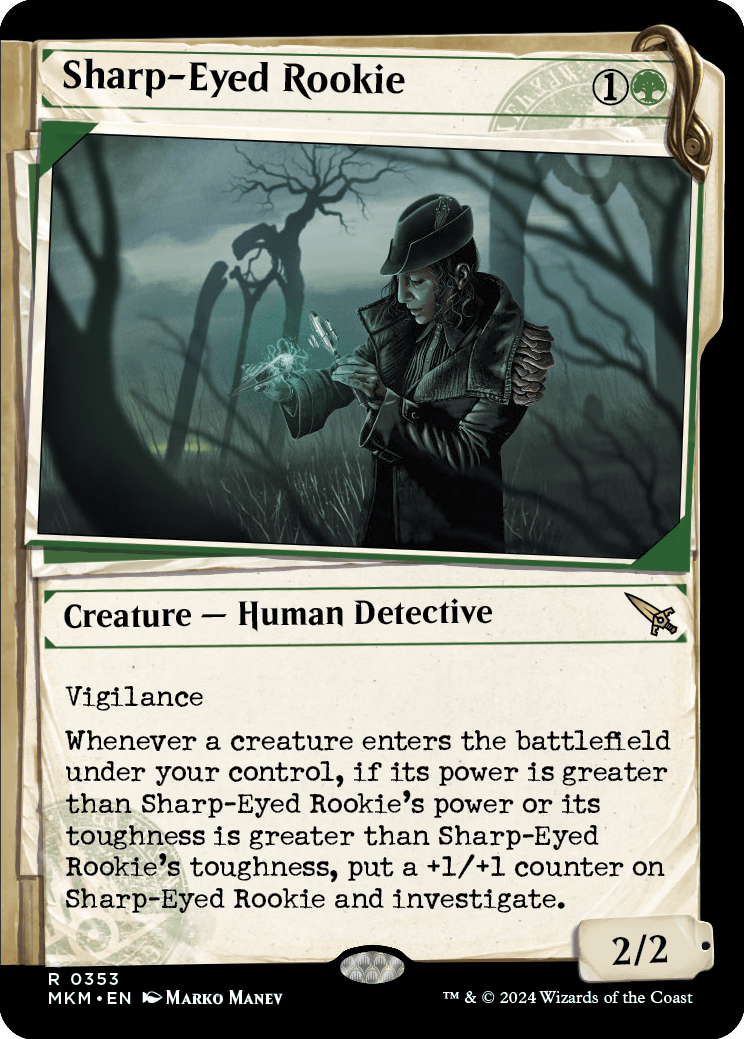
Sharp-Eyed Rookie (Showcase Dossier) Because we were on Ravnica, one of the things we liked to do was make nods to mechanics from past Ravnica sets. Sharp-Eyed Rookie is a nod to the Simic mechanic evolve from Gatecrash. It was fun to use investigate as an output combined with evolve's input.
The third and final preview is called No Witnesses.
-
Click here to reveal No Witnesses
-

No Witnesses 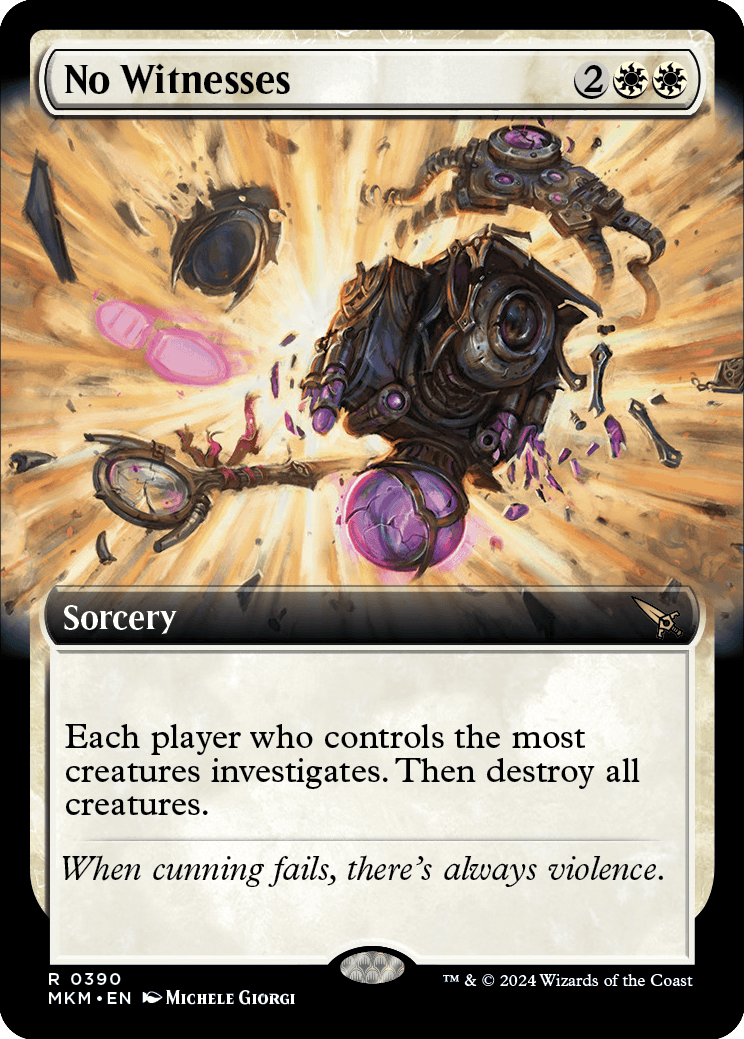
No Witnesses (Extended Art) No Witnesses shows off the flexibility of investigate being a keyword action. Yes, we can use it on permanents but also on spells.
Anyway, the story of investigate is short and simple. It was an obvious inclusion. We included it. The next mechanic went through a bit more on its journey into the set.
Hidden in the Shadows
On the very first day of exploratory design, we did our usual exercise of compiling a list of everything a murder mystery set should have. One thing we wrote was "hidden information." The whole point of a murder mystery is that someone must solve it. If we were going to capture a sense of mystery in gameplay, there needed to be something that players didn't know that they had to figure out.
So, we thought through every past gameplay element where there was an aspect of hidden information. An important component we realized was that the opponent(s) understood there was something they didn't know. Mechanics that lived in the hand, for instance, didn't quite meet this requirement because players (almost) always have cards in their hand, so it doesn't have the "there's a mystery for me to solve" quality we wanted. We wanted you to play a card that made the opponent(s) aware that there was something they had to figure out.
We explored a lot of different mechanical veins and ended up on face-down cards. A face-down card does a great job of saying, "I know something you don't know, and the thing you don't know might cause you problems." We looked at both face-down permanents and face-down cards that lived in exile, usually spells that you would eventually cast. In the end, we gravitated to the thing that we looked at first, morph.
The morph mechanic was created by the rules team. They were figuring out how to make the Limited Edition (Alpha) cards
We brought it back for Khans of Tarkir. It was clear to us at the time that three mana for a 2/2 was a little on the weak side. Creatures have been improved over the years, and morph hadn't kept up. We tried a few variants, such as borph (i.e., "bear morph" where it was a 2/2 for two), smorph (a 2/2 for four that came with a +1/+1 counter), and auramorph (morph where the back was an Aura rather than a creature and turning it face up allowed you to put it on a creature) but none were used.
Because we knew that we could fall back to morph, we decided it made sense to experiment some more. The first version of our new morph variant (which we called cloak but went to print as disguise—the word "cloak" is used in the set for a manifest-like variant) was a 3/2 for three. An important part of morph is that face-down morph cards trade with one another, so giving it a power of 3 but leaving the toughness at 2 helped retain that quality.
But a 3/2 is a little too efficient at dealing damage and ended up trading well with creatures, so it usually died before being turned face up. A lot of the fun of a morph mechanic is the ability to turn it into something. Also, because we wanted to play into the mystery aspect, we wanted the opponent(s) to have the chance to see if they correctly identified what it was. We realized we needed to try something else.
So, we asked ourselves, how do we make the creature slightly better but in a way that increases its chance of survival such that it gets to turn face up? We still wanted it to trade in combat with other face-down creatures, so we didn't want to mess with the toughness of the creature. This led us to look at mechanics that helped protect it. Eventually, we settled on ward. It made the face-down creature harder to kill with spells and increased its survival but didn't mess with the interaction we wanted in combat. We ended up starting with ward 2, as it seemed aesthetic with it being a 2/2 (which also meant it would be easier to remember). Ward 2 played well and stayed until print.
During set design, the team would add a manifest variant (turn a card face down and you may pay its mana cost to turn it face up if it's a creature). This would allow you to take cards without the mechanic and turn them face down. What we called cloak was changed to disguise, and the manifest variant keyword action became cloak.
The Mystery Deepens
That's all the time I have for today. Next week, I'll continue telling the story of the set's design and talk about the other mechanics and themes in the set. As always, I'm eager for your feedback. You can email me or contact me through any of my social media accounts (X [formerly Twitter], Tumblr, Instagram, and TikTok) to share any feedback about today's column or any aspect of Murders at Karlov Manor.
Join me next week for part two.
Until then, may you solve all the mysteries that come your way.

